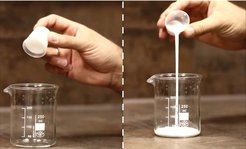Yogurt with dandelions? Stirred and shaken!
Scientists at the Max Planck Institute for Polymer Research investigate the structure of inulin
Inulin is a molecule present in various foods, which can be obtained for example from chicory, dandelion or sunflower roots. Due to its special structure, inulin has in-mouth melting and creamy properties and is suitable as a calorie-reduced fat substitute for a healthy diet. Scientists at the Max Planck Institute for Polymer Research (MPI-P) have now studied the physical properties of various inulin preparations. In particular, they have measured the dependence of the viscosity of inulin-water mixtures, so-called inulin gels, on the temperature and on mechanical forces. The results can help to improve the mouthfeel of food.

Inulin is a long-chained molecule that is present in various foods, but also plants such as chicory or dandelion. Chemically, it is an almost indigestible carbohydrate and thus can serve as roughage for the human body. Among other applications, inulin is used today to increase the amount of roughage in sausages. In yogurt it is already used today as a fat substitute. At the same time, it changes the so-called "texture" of the yogurt, the feeling yoghurt leaves on the tongue. But why is it like that? How exactly inulin reacts to temperature changes or mechanical stress - which can occur when masticating or chewing - and how to produce food with specific properties was now studied in detail by scientists around Prof. Dr. Thomas Vilgis (Department of Prof. Dr. Kurt Kremer) at the MPI-P.
For this they have prepared inulin gels under different preparation conditions and studied the viscosity at different temperatures. In a theoretical model of the researchers, inulin is described on a molecular scale as small, sometimes flexible rods, which are dissolved under stirring in water. Cooling such a liquid causes the rods to line up, leading to a crystallization of the liquid and therefore giving it a different texture. In this case, these small crystals are packed in a very particular way in an irregular manner - so-called fractal aggregates. Strong heating or mechanical stress leads again to a strong liquefaction (see video). The flow properties can thus be accurately adjusted, and solid becomes liquid after shaking.
Overall, the researchers conclude that inulin gels produced at low temperatures around 25 °C are firmer than those produced at higher temperatures around 60 °C. This is because at 25 °C still some of the inulin molecules in the water are undissolved and thus serve as seeds for the formation of small "inulin crystals", which then combine and provide strength. At 60 °C, most of the inulin molecules are already dissolved, which results in fewer but larger inulin crystals, less bonding, and thus lower strength.
The destruction of these aggregates between the tongue and the palate is responsible for the amazing creamy and oily mouthfeel. Food is, at least in part, pure physics. The researchers have now published their findings in the renowned journal "Food Hydrocoloids".












